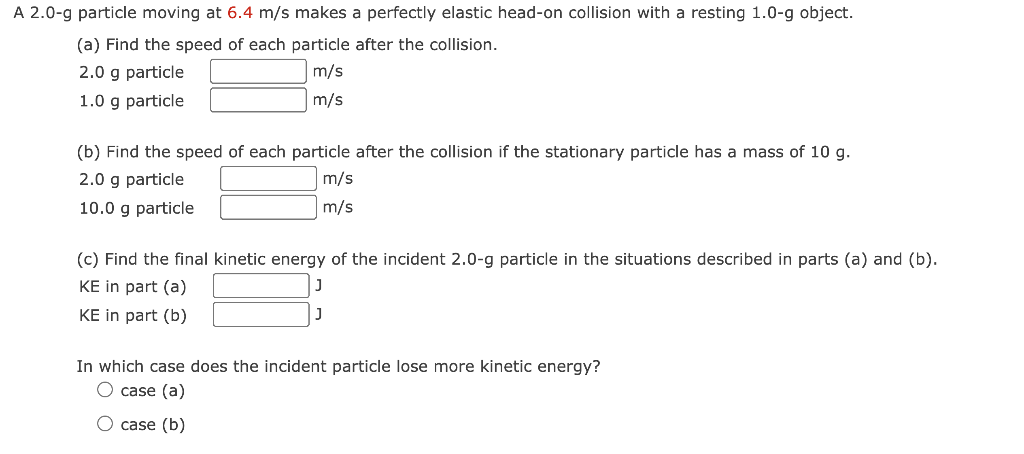A 2.0-g particle moving at 6.4 m/s makes a perfectly elastic head-on collision with a resting 1.0-g object. (a) Find the speed of each particle after the collision. 2.0 g particle m/s 1.0 g particle m/s (b) Find the speed of each particle after the collision if the stationary particle has a mass of 10 g. 2.0 g particle m/s 10.0 g particle m/s (c) Find the final kinetic energy of the incident 2.0-g particle in the situations described in parts (a) and (b). KE in part (a) J KE in part (b) In which case does the incident particle lose more kinetic energy? O case (a) case (b)
A 2.0-g particle moving at 6.4 m/s makes a perfectly elastic head-on collision with a resting 1.0-g object. (a) Find the speed of each particle after the collision. 2.0 g particle m/s 1.0 g particle m/s (b) Find the speed of each particle after the collision if the stationary particle has a mass of 10 g. 2.0 g particle m/s 10.0 g particle m/s (c) Find the final kinetic energy of the incident 2.0-g particle in the situations described in parts (a) and (b). KE in part (a) J KE in part (b) In which case does the incident particle lose more kinetic energy? O case (a) case (b)
College Physics
10th Edition
ISBN:9781285737027
Author:Raymond A. Serway, Chris Vuille
Publisher:Raymond A. Serway, Chris Vuille
Chapter6: Momentum And Collisions
Section: Chapter Questions
Problem 55AP: A 2.0-g particle moving at 8.0 m/s makes a perfectly elastic head-on collision with a resting 1.0-g...
Related questions
Question
Please asap with explanation

Transcribed Image Text:A 2.0-g particle moving at 6.4 m/s makes a perfectly elastic head-on collision with a resting 1.0-g object.
(a) Find the speed of each particle after the collision.
2.0 g particle
m/s
1.0 g particle
m/s
(b) Find the speed of each particle after the collision if the stationary particle has a mass of 10 g.
2.0 g particle
m/s
10.0 g particle
m/s
(c) Find the final kinetic energy of the incident 2.0-g particle in the situations described in parts (a) and (b).
KE in part (a)
J
KE in part (b)
In which case does the incident particle lose more kinetic energy?
O case (a)
case (b)
Expert Solution
This question has been solved!
Explore an expertly crafted, step-by-step solution for a thorough understanding of key concepts.
Step by step
Solved in 4 steps with 3 images

Knowledge Booster
Learn more about
Need a deep-dive on the concept behind this application? Look no further. Learn more about this topic, physics and related others by exploring similar questions and additional content below.Recommended textbooks for you

College Physics
Physics
ISBN:
9781285737027
Author:
Raymond A. Serway, Chris Vuille
Publisher:
Cengage Learning

Physics for Scientists and Engineers, Technology …
Physics
ISBN:
9781305116399
Author:
Raymond A. Serway, John W. Jewett
Publisher:
Cengage Learning

Physics for Scientists and Engineers with Modern …
Physics
ISBN:
9781337553292
Author:
Raymond A. Serway, John W. Jewett
Publisher:
Cengage Learning

College Physics
Physics
ISBN:
9781285737027
Author:
Raymond A. Serway, Chris Vuille
Publisher:
Cengage Learning

Physics for Scientists and Engineers, Technology …
Physics
ISBN:
9781305116399
Author:
Raymond A. Serway, John W. Jewett
Publisher:
Cengage Learning

Physics for Scientists and Engineers with Modern …
Physics
ISBN:
9781337553292
Author:
Raymond A. Serway, John W. Jewett
Publisher:
Cengage Learning

Principles of Physics: A Calculus-Based Text
Physics
ISBN:
9781133104261
Author:
Raymond A. Serway, John W. Jewett
Publisher:
Cengage Learning

College Physics
Physics
ISBN:
9781938168000
Author:
Paul Peter Urone, Roger Hinrichs
Publisher:
OpenStax College

Physics for Scientists and Engineers
Physics
ISBN:
9781337553278
Author:
Raymond A. Serway, John W. Jewett
Publisher:
Cengage Learning